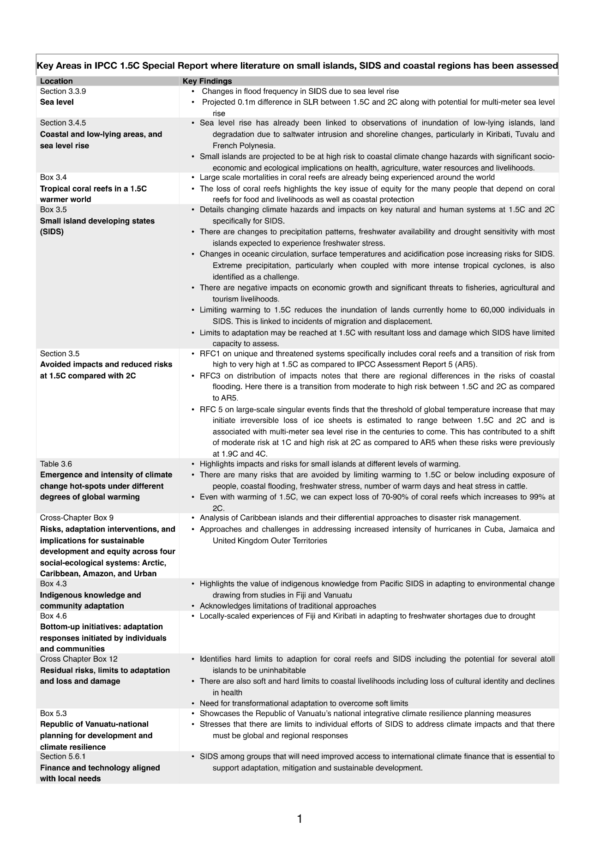Key Messages for Small Island Developing States from the IPCC 1.5°C Special Report
Small Island Developing States (SIDS) have been advocating for at least a decade for the establishment of 1.5°C as an upper limit for global average temperature increase - due to their high vulnerability to increased climate impacts. This latest IPCC 1.5°C Special Report provides the scientific assessment that supports the long-established cry of SIDS to limit global temperatures and the risks that threaten these small island nations.
Share

For many years, AOSIS has been a strong advocate for establishing 1.5°C as an upper limit for global temperature increase. Since 2009, the group has used the “1.5 to Stay Alive” slogan to highlight the existential risks that increased warming poses to SIDS.
AOSIS was actively engaged in the Structured Expert Dialogue in 2015 which concluded that there was a significant difference in projected risks for small islands between 1.5°C and 2°C of warming. And there have been many other creative activities from SIDS over the years to highlight the need to limit global temperature rise.
All of this action culminated in leadership and advocacy from AOSIS at COP21 in Paris that resulted in the Paris Agreement including the 1.5°C temperature limit and the call for a special report to be produced by the IPCC.
Overall Key Messages
With this background of sustained advocacy around the 1.5°C temperature limit, the entire IPCC 1.5°C Special Report can be viewed as being of critical importance for AOSIS. The IPCC has summarised the overall key messages of the report into three direct and easily digestible points:
- Half a degree matters
- Each year matters
- Each choice matters
Certainly, these overall key messages from the report are highly relevant in showing the importance of the 1.5°C limit, not only for SIDS but for the world, and also for identifying that urgent and transformative action is needed to get us there.
Key Messages for SIDS
However, the report also assesses literature specifically on SIDS, small islands and coastal regions as summarised in Table 1. Messages from this assessment are recapped in the Summary for Policy Makers (SPM), pulled from the full report. The SPM states that:
- There are greater opportunities for adaptation for small islands and coastal areas if the rate of sea level rise is slower (SPM Statement B.2)
- Threats of sea level rise to small islands and coasts includes saltwater intrusion, flooding and damage to infrastructure (SPM Statement B.2.3)
- Limiting warming to 1.5°C lowers impacts on coastal ecosystems and retains critical ecosystem services (SPM Statement B.3)
- There is a risk of irreversible loss of marine and coastal resources as temperatures increase, particularly for coral reefs where 99% of these ecosystems are projected to decline at 2°C. (SPM Statement B.4.2)
- Communities dependent on coastal livelihoods and SIDS have disproportionately higher risk of adverse consequences as temperatures rise (SPM Statement B.5.1)
- Adaptation will be more challenging at 2°C and small islands are projected to experience high, multiple and interrelated risks even at 1.5°C. (SPM Statement B.6.2)
So, drawing from all of these instances where literature on small islands, SIDS and coastal regions are mentioned, key messages can be synthesised as:
- Impacts of climate change are already being experienced in small islands
- Risks of climate change are more significant than previously assessed with substantial differences between 1.5°C and 2°C for small islands
- Limiting warming to 1.5°C provides more opportunities for adaptation for small islands, but there is still potential of irreversible losses at 1.5°C
- Limits to adaptation and loss and damage for SIDS will occur as temperatures rise
- SIDS are already adapting to climate change but international cooperation, action and support is needed
At the same time, the report has established that limiting warming to 1.5°C can be achieved under a range of different scenarios of future socio-economic development. However, achieving 1.5°C requires decisive near term action. This includes, in particular, the need for more ambitious Nationally Determined Contributions (NDCs) as the current ambition of countries would rule out achieving 1.5°C. The report is clear that we need redoubled efforts to limit warming. (see here for more information on what the report says about how to achieve 1.5°C)
Following the intense media coverage and publicity on the outcomes of the special report, it may seem that some of these key findings are fairly obvious. And indeed, AOSIS has been advocating for years on some of these very issues. However, one of the many values of the report is in providing the scientific assessment that supports the concerns of SIDS on how climate change is and will continue to affect them.
Linkages to UNFCCC Process
These specific key messages that are relevant for SIDS, along with broader messages on the need for urgent and widespread action to achieve the 1.5°C limit, have been well taken up by AOSIS. The group has already been strongly advocating for mainstreaming the special report in the UNFCCC process. At the SBSTA/IPCC Special Event at COP24 in Katowice this week, AOSIS called for more ambitious new and updated nationally determined contributions (NDCs) in line with 1.5°C to come forward by 2020, for reference to the special report to be reflected in a COP decision, for development of a work programme on implementation of the special report and for making finance the topic of an upcoming research dialogue.
The group also called for a strong outcome of the Talanoa Dialogue to build on the momentum towards more ambition up to 2020.













